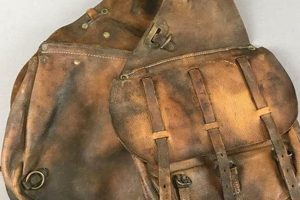A pre-owned Coach bag, designed to be worn across the body, represents a specific era in the brand’s history. These items, often characterized by specific hardware, materials, and construction techniques, embody a classic aesthetic and a practical carrying solution. An example is a 1970s-era City Bag with its simple, unfussy design and durable leather construction.
Acquiring such an item offers several advantages. Beyond its functionality, it provides a tangible connection to a specific period of design and manufacturing. Its value lies not only in its enduring style, often immune to fleeting trends, but also in its potential for appreciation as a collectible item. Furthermore, selecting this pre-owned piece promotes sustainability by extending the lifespan of existing goods.
The following sections will delve into the identifying characteristics of these sought-after pieces, discuss their restoration and care, and provide guidance on authenticating their origins and value.
Tips for Acquiring a Vintage Coach Crossbody Bag
This section offers guidance for individuals seeking to acquire a pre-owned Coach bag intended for crossbody wear. The following points outline key considerations to ensure a satisfactory acquisition.
Tip 1: Inspect the Leather Quality: Examine the leather for signs of wear, cracking, or discoloration. Genuine, high-quality leather will exhibit a supple texture and consistent color. Avoid bags with excessive stiffness or flaking, indicating potential degradation.
Tip 2: Evaluate the Stitching and Hardware: Scrutinize the stitching for uniformity and secure attachment. Hardware should be solid brass or a similarly durable metal, exhibiting minimal tarnishing or rust. Inconsistent stitching or flimsy hardware can suggest a replica.
Tip 3: Verify the Creed and Serial Number: Locate the creed stamp inside the bag. This stamp includes the Coach creed and a serial number. Research the serial number to confirm its authenticity and production date. A missing or poorly executed creed is a significant red flag.
Tip 4: Assess the Lining: The interior lining should be intact and clean. Common lining materials include fabric or leather. Tears, stains, or a foul odor can detract from the bag’s value and usability.
Tip 5: Examine the Strap and Attachment Points: The crossbody strap should be securely attached to the bag, with no signs of stress or weakening. Ensure the strap is the appropriate length and style for the bag’s design.
Tip 6: Consider the Bag’s Overall Condition: Assess the bag’s structural integrity. Look for signs of warping, sagging, or misshapen areas. A bag in good condition will maintain its original form and functionality.
Tip 7: Research the Specific Model: Identify the specific model of the bag. Understanding the bag’s original design, features, and era of production will aid in accurate assessment and valuation.
Acquiring an authentic and well-preserved piece requires careful attention to detail. By focusing on material quality, construction, and identifying marks, prospective buyers can increase their chances of securing a desirable item.
The subsequent sections will explore the restoration and preservation of these vintage items.
1. Authenticity verification
The verification of authenticity is paramount when assessing a pre-owned Coach bag intended for crossbody wear. Counterfeit items proliferate the secondary market, necessitating careful scrutiny to ensure a genuine acquisition.
- Creed and Serial Number Examination
The Coach creed, a stamped statement within the bag, details the brand’s commitment to quality. It includes a serial number. This number serves as a unique identifier, allowing for cross-referencing with Coach’s internal records. Discrepancies in the creed’s wording, font, or the serial number’s format indicate a potential counterfeit. For instance, a serial number that does not conform to Coach’s established coding system or appears to be a duplicate raises immediate concerns.
- Hardware Assessment
Authentic Coach bags feature solid brass or high-quality metal hardware. This hardware often bears the Coach logo or branding. Fakes typically employ inferior metals, resulting in rapid tarnishing or breakage. Examining the weight, finish, and markings on buckles, clasps, and zippers provides crucial clues. An example would be a zipper pull that feels lightweight and lacks the Coach engraving, suggesting a lower-quality imitation.
- Stitching and Construction Analysis
Coach bags are renowned for their meticulous stitching and construction. Genuine articles exhibit consistent, even stitching throughout. Counterfeits often display uneven, loose, or poorly aligned seams. Inspecting the bag’s internal structure, including the lining and pockets, reveals further discrepancies. For example, a crookedly sewn pocket or a lining made of cheap fabric are indicators of inauthenticity.
- Leather Quality Evaluation
The quality of the leather is a primary indicator. Authentic Coach bags utilize high-grade leather, which ages gracefully and possesses a distinctive aroma. Counterfeits frequently employ synthetic materials or inferior leather substitutes that lack the suppleness and durability of the real thing. A leather that feels plasticky, smells strongly of chemicals, or shows immediate signs of cracking upon bending is likely not genuine Coach leather.
These authentication methods collectively contribute to establishing the veracity of a claimed “vintage Coach crossbody bag.” By diligently applying these techniques, potential buyers can minimize the risk of acquiring a counterfeit item and ensure an informed purchase decision. These methods can be combined with professional authentication services for high confidence or high-value acquisitions.
2. Leather Quality
The inherent value and longevity of a vintage Coach crossbody bag are inextricably linked to the leather quality employed in its construction. The choice of leather, its tanning process, and subsequent treatment directly influence the bag’s durability, aesthetic appeal, and overall collectibility. Superior leather resists wear and tear, developing a desirable patina over time. Conversely, inferior leather is prone to cracking, discoloration, and structural failure, significantly diminishing the bag’s worth. For instance, a vintage Coach City Bag crafted from full-grain leather, properly maintained, can retain its structural integrity and visual appeal for decades, whereas a bag utilizing corrected-grain leather may exhibit premature aging and degradation.
Leather quality also impacts the bag’s tactile experience and perceived luxury. A supple, well-conditioned leather conveys a sense of quality and craftsmanship that is immediately apparent to the user. Furthermore, the type of leather used often correlates with the bag’s era of production and intended market. Vintage Coach bags produced in the 1970s and 1980s frequently utilized thicker, more robust leathers than later models, reflecting a shift in production practices and design aesthetics. Understanding the specific leather characteristics associated with different eras and models is crucial for authentication and valuation purposes. For example, the presence of glove-tanned cowhide, a signature material of early Coach designs, can be a strong indicator of authenticity.
In conclusion, leather quality serves as a critical determinant of a vintage Coach crossbody bag’s overall desirability and value. Its influence extends beyond mere aesthetics, encompassing durability, tactile appeal, and historical context. A comprehensive understanding of leather types, tanning processes, and aging characteristics is essential for collectors and enthusiasts seeking to acquire and preserve these enduring artifacts. Neglecting the aspect of leather quality can lead to misidentification, overvaluation, and ultimately, a diminished ownership experience.
3. Hardware condition
The state of the hardware on a pre-owned Coach crossbody bag serves as a crucial indicator of its overall condition, authenticity, and potential value. Hardware encompasses all metallic components, including buckles, clasps, zippers, rings, and decorative accents. Its integrity directly impacts the bag’s functionality and aesthetic appeal. Deterioration or replacement of hardware can significantly detract from the bag’s collectibility and market value. Therefore, a thorough assessment of the hardware is paramount when evaluating a vintage Coach crossbody bag.
- Material Composition and Authenticity
Authentic vintage Coach bags primarily utilized solid brass hardware. Brass offers durability and a characteristic warm tone. The presence of other metals, such as plated alloys, raises immediate suspicion regarding authenticity. The hardware should exhibit a consistent finish and lack signs of flaking or corrosion. For example, examine the D-rings connecting the strap to the bag; genuine brass D-rings will exhibit a substantial weight and a subtle, natural patina over time, whereas imitation hardware may feel lightweight and display an artificial sheen.
- Functionality and Structural Integrity
All functional hardware components, such as buckles and zippers, must operate smoothly and securely. A malfunctioning zipper or a loose buckle compromises the bag’s usability and indicates potential repair needs. Inspect the attachment points of hardware to the bag’s leather; loose stitching or signs of stress around these points suggest weakened connections and potential failure. For instance, a broken zipper pull or a buckle that does not latch properly renders the bag less functional and reduces its value.
- Corrosion and Patina
The presence of corrosion or excessive tarnish on the hardware can detract from the bag’s appearance and potentially weaken its structure. However, a certain degree of patina, a natural aging process affecting brass, can be desirable, contributing to the bag’s vintage character. Distinguish between an attractive patina and detrimental corrosion; the former enhances the bag’s aesthetic, while the latter indicates neglect and potential structural damage. An example would be a subtle darkening of brass buckles on a well-maintained bag versus green verdigris forming on corroded clasps due to exposure to moisture.
- Matching Hardware and Era Consistency
Ensure all hardware components are consistent with the bag’s era of production and design. Mismatched or replaced hardware can significantly diminish the bag’s value and authenticity. Research the specific hardware styles and finishes associated with different Coach models and production periods. For instance, a late 1990s Coach bag with early 1970s-style solid brass hardware raises concerns about originality and could indicate a replaced component.
In summary, a careful evaluation of the hardware condition on a vintage Coach crossbody bag provides valuable insights into its authenticity, functionality, and overall state of preservation. By scrutinizing the material composition, functionality, patina, and era consistency of the hardware, prospective buyers can make more informed decisions and avoid potentially costly acquisitions of misrepresented or poorly maintained items. The state of the hardware is a key element in determining the value and collectibility of these vintage accessories.
4. Style evolution
The stylistic trajectory of the vintage Coach crossbody bag reflects evolving trends in fashion and societal norms. The adaptation of design elements, materials, and functionalities across different eras significantly shapes the collectibility and historical significance of these artifacts.
- Material Innovation and Adaptation
Early Coach crossbody bags often featured thicker, more robust leathers, aligning with a focus on durability and longevity. As fashion sensibilities shifted, lighter-weight leathers and alternative materials such as nylon were introduced to cater to evolving consumer preferences. This transition exemplifies the adaptation of materials to meet changing demands and aesthetic ideals. For instance, the introduction of brightly colored leather options in the 1980s reflected a departure from the more muted tones of earlier decades.
- Hardware Design Modifications
The design of hardware, including buckles, clasps, and zippers, underwent notable transformations throughout the Coach brand’s history. Early models typically featured solid brass hardware, emphasizing durability and a classic aesthetic. Subsequent iterations incorporated more stylized and streamlined hardware designs, reflecting contemporary fashion trends. The evolution from utilitarian hardware to more decorative elements illustrates the influence of stylistic trends on functional components. The shift from simple brass buckles to more ornate, logo-emblazoned hardware exemplifies this evolution.
- Silhouette and Size Variations
The silhouette and size of Coach crossbody bags evolved in response to changing lifestyle patterns and functional requirements. Early models often featured compact designs, prioritizing practicality and ease of carrying. Later designs incorporated larger silhouettes and more spacious compartments to accommodate the increasing demands of modern life. This adaptation reflects the evolving needs of consumers and the brand’s commitment to providing functional and stylish solutions. The transition from smaller, minimalist bags to larger, multi-compartment designs reflects this shift.
- Branding and Logo Integration
The integration of branding elements, such as the Coach logo, evolved significantly over time. Early models often featured subtle or understated branding, emphasizing the quality of materials and craftsmanship. Subsequent iterations incorporated more prominent logo placements and branding strategies to enhance brand recognition and market presence. The evolution from discreet branding to more overt logo displays illustrates the influence of marketing trends on design aesthetics. For example, the gradual increase in the size and prominence of the Coach logo on various bag models reflects this trend.
These elements demonstrate the impact of style evolution on the design and features of Coach crossbody bags. Recognizing these stylistic shifts aids in accurate dating, authentication, and appreciation of these items. The adaptations and changes are not merely cosmetic; they reflect the brand’s response to broader cultural and economic shifts, solidifying the vintage Coach crossbody bag as a tangible representation of fashion history.
5. Collectibility potential
The collectibility potential of a vintage Coach crossbody bag is a multifaceted consideration, intrinsically linked to its condition, rarity, and historical significance. The inherent desirability as a collectible is directly influenced by factors such as the bag’s original design, the materials used in its construction, and its state of preservation. A bag exhibiting pristine condition, featuring a rare design or limited-edition release, commands a higher collectibility value than a more common model displaying significant wear. For example, the original Coach City Bag in a unique color, such as British Tan, and retaining its original hangtag, exhibits strong collectibility potential due to its iconic design and limited availability in certain iterations.
The collectibility of these items is also affected by shifting fashion trends and cultural nostalgia. As certain styles regain popularity, the demand for vintage Coach crossbody bags that embody those trends increases, driving up their value in the secondary market. Further, the recognition of specific Coach models as representative of a particular era or design aesthetic contributes to their desirability among collectors. Limited edition collaborations or bags designed under specific creative directors can achieve increased collectibility due to their unique characteristics and historical significance. The impact of celebrity endorsements or appearances in popular media can also affect market values.
Understanding the collectibility potential of a vintage Coach crossbody bag is practically significant for both buyers and sellers. For collectors, it informs investment decisions and guides the acquisition of pieces with enduring value. For sellers, it allows for accurate valuation and strategic marketing to maximize returns. Accurately assessing the bag’s rarity, condition, and historical context is vital for determining its collectibility potential. Ultimately, the long-term appreciation and cultural relevance of these vintage items depend on their continued recognition and preservation by enthusiasts and collectors.
6. Functional design
The functional design of a vintage Coach crossbody bag is a primary factor contributing to its enduring appeal and sustained value. These bags were conceived with a specific purpose: to provide a secure, convenient, and accessible method of carrying personal belongings. This focus on functionality dictated key design elements, including the crossbody strap for hands-free mobility, secure closures to protect contents, and thoughtfully arranged interior compartments for organization. The practical benefit of a hands-free carrying solution is evident in the bag’s widespread adoption across diverse lifestyles and activities. A representative example is the classic Courier Bag, whose adjustable strap and multiple compartments facilitated ease of use in various professional and leisure settings. The durability of the materials, chosen for their ability to withstand daily wear, further underscores the design’s pragmatic intentions.
Further contributing to the functional design is the careful consideration of access and security. Many vintage Coach crossbody bags feature flap closures with turn-lock mechanisms or zippered tops, deterring unauthorized access. The placement of pockets, both interior and exterior, is strategically planned to optimize the organization and retrieval of items. For instance, an exterior slip pocket allows for quick access to frequently used items like keys or a phone, while an interior zippered pocket provides secure storage for valuables. The size and shape of the bag are also deliberate, reflecting a balance between carrying capacity and ease of maneuverability. The designs avoid excessive bulk, ensuring the bag remains comfortable to wear for extended periods.
In conclusion, the functional design of a vintage Coach crossbody bag is not merely an aesthetic consideration but rather a fundamental aspect that defined its purpose and influenced its enduring appeal. The emphasis on practicality, security, and user-friendliness directly contributed to the bag’s popularity and its continued relevance in contemporary fashion. Recognizing this functional design allows for a greater understanding and appreciation of its enduring appeal. The value placed on functionality, even in vintage pieces, highlights the importance of considering utility when assessing long-term design success.
Frequently Asked Questions
This section addresses common inquiries and concerns regarding pre-owned Coach bags designed for crossbody wear. The following questions and answers aim to provide clarity and enhance understanding of these items.
Question 1: How can the authenticity of a “vintage coach crossbody bag” be verified?
Authenticity verification involves examining the creed and serial number, assessing the hardware quality, scrutinizing the stitching, and evaluating the leather. Discrepancies in any of these areas may indicate a counterfeit.
Question 2: What factors influence the value of a “vintage coach crossbody bag”?
The value is determined by the bag’s condition, rarity, style, and historical significance. Bags in excellent condition, featuring rare designs or limited-edition releases, typically command higher prices.
Question 3: How should a “vintage coach crossbody bag” be properly cleaned and maintained?
Cleaning and maintenance involve gentle cleaning with a leather cleaner, conditioning the leather to prevent drying, and storing the bag in a dust bag to protect it from damage.
Question 4: What are the common signs of wear to look for when purchasing a “vintage coach crossbody bag”?
Common signs of wear include scratches, discoloration, cracking, and loose stitching. Careful inspection of these areas is essential before making a purchase.
Question 5: What is the significance of the creed and serial number on a “vintage coach crossbody bag”?
The creed and serial number serve as unique identifiers. The creed contains a statement of quality, while the serial number allows for tracing the bag’s production history. Their absence or inconsistency is a red flag.
Question 6: Where are the best places to purchase a genuine “vintage coach crossbody bag”?
Reputable sources for purchasing include established vintage boutiques, consignment shops specializing in luxury goods, and online marketplaces with robust authentication processes.
In summary, careful attention to detail and thorough research are critical when acquiring a pre-owned Coach bag. Authentication, condition assessment, and proper maintenance contribute to its long-term value and enjoyment.
The next section will explore specific vintage Coach crossbody bag models and their distinguishing features.
Conclusion
The preceding analysis has explored the multifaceted nature of the vintage Coach crossbody bag, emphasizing its enduring appeal rooted in quality materials, functional design, and stylistic evolution. The verification of authenticity, assessment of leather and hardware, and understanding of collectibility potential have been presented as critical considerations for both prospective buyers and enthusiasts. Each component contributes to the overall value and historical significance of these pre-owned accessories.
The preservation and appreciation of these items serve as a testament to enduring design principles and the cyclical nature of fashion. Continued diligence in authentication and responsible restoration efforts will ensure the legacy of the vintage Coach crossbody bag for future generations. The careful selection, maintenance, and informed appreciation of these bags represent an investment in a tangible piece of fashion history.







